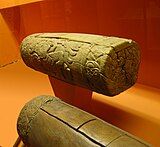Slit drum

A slit drum or slit gong is a hollow percussion instrument. In spite of its often being called a drum, it is not a true drum because it lacks a drumhead, the membrane stretched across the top of a true drum. It is classed instead as an idiophone in which the entire instrument vibrates.
Description
[edit]A slit drum is usually carved or constructed from bamboo or wood, in the form of a mostly closed hollow chamber with one or more slits in it. It is played by striking near the edge of the slit. In some designs, the slit is a single straight line; in others, the slit is used to create one or more "tongues", achieved by cutting three sides of a rectangular (or similar) shape and leaving the fourth side attached. Most slit drums have one slit, though two and three slits (often resembling an "H" and thereby forming two tongues) occur. Tongues of different areas or thicknesses will produce different pitches. Slit drums are used throughout Africa, Southeast Asia, and Oceania. In Africa, such drums are situated in strategic locations for optimal acoustic transmission (e.g., along a river or valley), in order to be used for long-distance communication.[1]
The ends of a slit drum are closed so that the shell becomes the resonating chamber for the sound vibrations created when the tongues are struck, usually with a stick or mallet. The resonating chamber increases the volume of the sound produced by the tongue and presents the sound through an open port. If the resonating chamber is the correct size for the pitch being produced by the tongue, which means it has the correct volume of airspace to complete one full sound wave for that particular pitch, the instrument will be more efficient and louder.
The people of Vanuatu create a similar instrument out of a large log. In most islands, the drum lies horizontally on the ground.[2] In the central islands, slit drums are erected vertically, and adorned with carvings on the outer surface, representing spirits. While traditional on one island only, this adorned type of drums have become one of the national emblems of Vanuatu as a whole.

List of slit drums
[edit]African
[edit]- Alimba – Zairean (Democratic Republic of the Congo)
- Ekwe – Igbo (Nigeria, Equatorial Guinea)
- Ikoro – Igbo (Nigeria, Equatorial Guinea)
- Krin (log drum) or Kolokolos – Guinea
- Lokole – Congo Basin
- Lukombé[3] – (Democratic Republic of the Congo)
- Mondo – West Africa
- Mukoku – Yaka people (Congo)
- Sudanese slit drum[4] – Sudanese (Sudan)
Austroasiatic
[edit]Austronesian
[edit]- Agung a Tamlang – Maguindanaon (Philippines)
- Atingting kon - Ambrym (Vanuatu)
- Kagul – Maguindanaon (Philippines)
- Kentongan – Javanese (Indonesia), used to wake people for sahur meals on Ramadan
- Kulkul – Balinese (Indonesia)
- Lali – Fijian (Fiji)
- Pahu – Māori (Aotearoa / New Zealand)[5]
- Pate – Samoa, Cook Islands, and other parts of Polynesia
- Tagutok (Philippine) – Maranao (Philippines)
- Tōʻere – Tahitian (Tahiti), also Tōkere by Tuamotuans, Mangarevans and Cook Islanders[6]
- Garamut – Papuan (Papua New Guinea)
Mesoamerican
[edit]- Huiringua – Mexico
- Mayohuacán – Taino people (Puerto Rico, Cuba, Dominican Republic, Caribbean)
- Teponaztli – Mesoamerican
Modern
[edit]- Gato – 20th-century American, originally a brand name, later generic[7]
- Tongue drum
Sinitic
[edit]
The wooden fish works like a slit drum but is rarely classified with the other slit drums.
Gallery
[edit]-
Two Aztec slit drums, called teponaztli. The characteristic "H" slits can be seen on the top of the drum in the foreground.
-
Ekwe drum of the Igbo people
-
Banda-Yangere animal-shaped slit drum
See also
[edit]Notes
[edit]- ^ Hart, Mickey; p. 52.
- ^ See p.77-78 of François & Stern (2013).
- ^ "Lukombé (slit drum) | Tetela, Kasai or Kusu". The Metropolitan Museum of Art. Retrieved 18 February 2023.
- ^ "BBC Radio 4 - A History of the World in 100 Objects, Mass Production, Mass Persuasion (1780 - 1914 AD), Sudanese slit drum - Episode Transcript – Episode 94 - Sudanese slit drum". BBC. Retrieved 2 August 2024.
- ^ https://nzetc.victoria.ac.nz/tm/scholarly/tei-BesGame-t1-body-d9-d2-d1.html [bare URL]
- ^ McLean, Mervyn (2010). "Music, Dance and Polynesian Origins: The Evidence From POc and PPn". Occasional Papers in Pacific Ethnomusicology (8). Archive of Māori and Pacific Music, The University of Auckland: 53–4. ISSN 1170-7941.
- ^ "Gato drum". Metropolitan Museum of Art. Archived from the original on 9 March 2016. Retrieved 29 June 2023.
- ^ Mercurio, Philip Dominguez (2006). "Traditional Music of the Southern Philippines". PnoyAndTheCity: A center for Kulintang – A home for Pasikings. Retrieved 12 June 2006.
References
[edit]- François, Alexandre; Stern, Monika (November 2013), Musiques du Vanuatu: Fêtes et Mystères – Music of Vanuatu: Celebrations and Mysteries (CD album, released with liner notes and ebook), label Inédit, vol. W260147, Paris: Maison des Cultures du Monde.
- Hart, Mickey, and Fredric Lieberman, with D. A. Sonneborn (1991). Planet Drum: A Celebration of Percussion and Rhythm. New York: HarperCollins. ISBN 9780062504142, ISBN 9780062503978, ISBN 9780062504623. OCLC 23357061.
External links
[edit]- Collins Rhythmcraft page on slit drums
- Drum Museum Siebenborn, Infos about antique slit drums and hand drums from Africa and New Guinea
- Beauty of Life Blog – A few examples of wooden slit gongs from Asia, including elephant bells.


![An example of a slit drum from the Philippines known as a kagul by the Maguindanaon people[8]](/uploads/wikipedia/commons/thumb/f/fe/Kagul.jpg/160px-Kagul.jpg?auto=webp)


